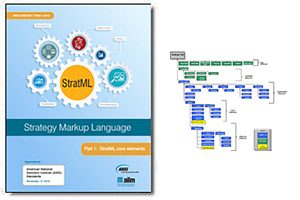One of Chris Argyris and Donald Schon’s more profound observations was the concept of espoused theory versus theory-in-use. When people describe how they behave, what they believe they do, what should be done, that is their espoused theory. What the person actually does in practice is their theory-in-use. Very often, the two are quite different. This is an important concept when consulting with clients – but one that applies equally to the consultant them self.
 Ask experienced management consultants what a good strategy should comprise and 90% of their descriptions are consistent. However, take a look at some of the strategies being created by and for organizations and too often you find something much less. Less in terms of insufficient clarity, completeness, and commitment.
Ask experienced management consultants what a good strategy should comprise and 90% of their descriptions are consistent. However, take a look at some of the strategies being created by and for organizations and too often you find something much less. Less in terms of insufficient clarity, completeness, and commitment.
So what is a good strategy, a specification that is not just theory but applied each and every time by seasoned professionals, and those coming up the consulting and leadership ladders?
My experience is that ‘corporate strategy’ comes to mind most often when business people hear the word strategy. However, there are also departmental strategies – IT, HR, Supply Chain, et al. Diversity and inclusion strategy, sustainability strategy, Go-to-Market strategy. Our M&A strategy, our outsourcing strategy, our approach for creating maximum value from our strategic alliance with partner x. How we are going to improve business process z, and the purpose and implementation of our new customer policy y, are all strategies.
Clearly, any group that intends to achieve some defined outcome will have a strategy and a strategic plan, to some greater or lesser degree – ‘a plan of action or policy designed to achieve a major or overall aim.’ to quote one of the many strategy definitions. This is why strong strategy skills are not just the purview of senior leadership.
 In the US, in 2010, the government passed the Government Performance and Results Modernization Act (GPRA). Dissatisfied with federal agencies spending money and time going into strategy projects, off-sites, and workshops, coming out with goals and plans that were weak in implementation, part of the act requires strategy transparency by agencies – specifically by making their strategies machine readable so they could be assessed for completeness.
In the US, in 2010, the government passed the Government Performance and Results Modernization Act (GPRA). Dissatisfied with federal agencies spending money and time going into strategy projects, off-sites, and workshops, coming out with goals and plans that were weak in implementation, part of the act requires strategy transparency by agencies – specifically by making their strategies machine readable so they could be assessed for completeness.
This led to stratml. As of March 21st, Part 1.0 is now an ISO standard. (Click here to read AIIM’s press release.)
To learn more about stratml, click here. The simple explanation is that a group’s strategy document when displayed in stratml format should demonstrate the core elements strategy professionals would espouse as good strategy – a vision, mission, stakeholders, goals, objectives, metrics, owners, and more. (The type of output consultants produce when using the SchellingPoint consulting software.)
 stratml does not ensure the quality of the strategy in terms of whether it is the right prescription for the stakeholders and their common topic – but an explicit data model against which to judge content completeness provides non-strategy specialists a straightforward structure to aim for, and a reminder for those who should be capable of assembling well-formed strategies.
stratml does not ensure the quality of the strategy in terms of whether it is the right prescription for the stakeholders and their common topic – but an explicit data model against which to judge content completeness provides non-strategy specialists a straightforward structure to aim for, and a reminder for those who should be capable of assembling well-formed strategies.
Congratulations to Owen Ambur and all those working hard to advance stratml.